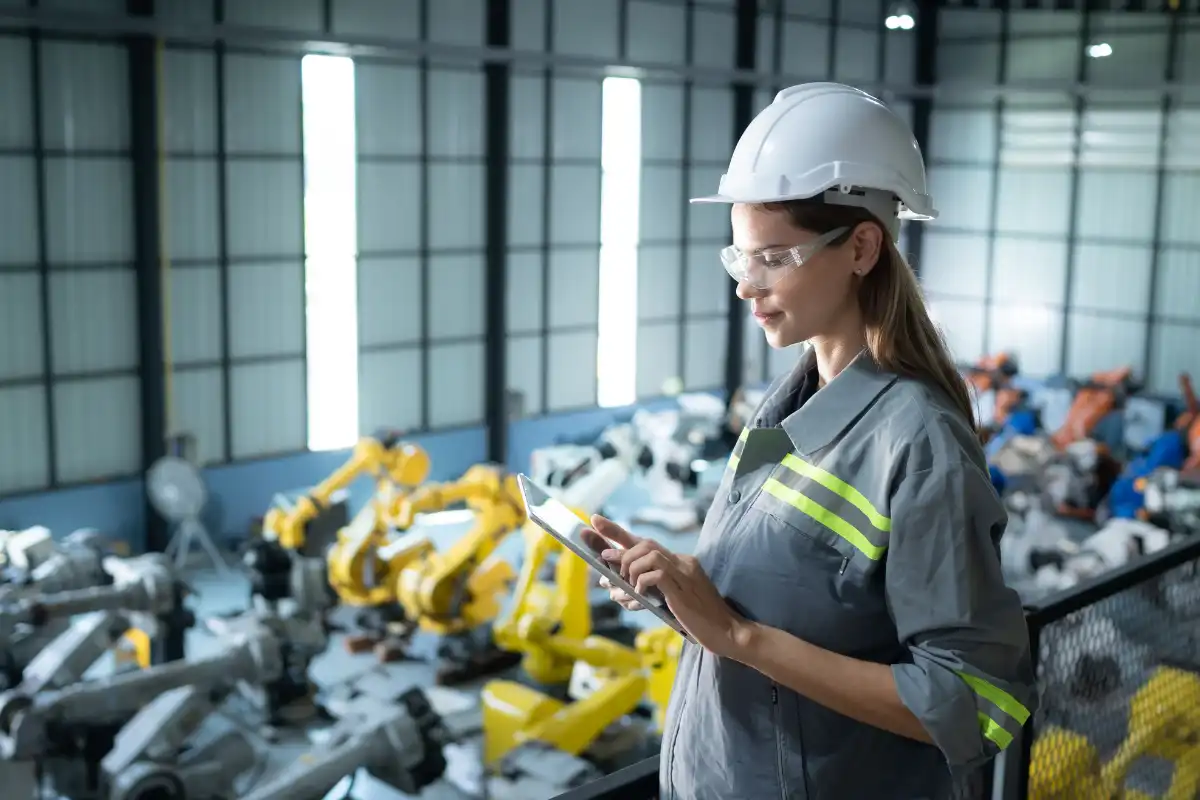
Just as the Internet of Things (IoT) has transformed consumer technology through greater connectivity and automation, the Industrial Internet of Things (IIoT) is reshaping manufacturing by making equipment smarter, more responsive, and more efficient.
Key takeaways
- IIoT technology significantly enhances digital twin readiness by feeding real-time data to virtual replicas of physical assets or processes. These digital twins can simulate operational conditions, identify inefficiencies, and optimize performance without interrupting actual production, leading to more informed decision-making and better operational outcomes.
- The integration of IIoT in maintenance and digital twin applications results in significant improvements in operational efficiency and cost savings. By leveraging real-time data and predictive analytics, companies can minimize downtime, optimize maintenance schedules, and improve overall asset performance.
- IIoT technology supports a shift from reactive to proactive maintenance strategies, which is essential for modern industrial operations. The shift not only reduces the risk of unexpected failures but also extends the lifespan of equipment and enhances the reliability of production processes.
For facility managers, embracing IIoT is not just about modernization. It’s an opportunity to set the stage for more informed, efficient, and resilient operations with predictive maintenance and digital twins.
What is the Industrial Internet of Things (IIoT)?
The Industrial Internet of Things (IIoT) is a network of interconnected industrial devices, machines, and systems that collect, exchange, and analyze data to optimize operations and support business decisions. It combines advanced sensors, data analytics, and real-time communication to create a more intelligent and responsive manufacturing environment. At a technical level, this involves integrating sensors and connected devices with a software platform to aggregate and analyze data.
The Industrial IoT market in North America alone is projected to reach $106.09 billion by 2025, driven by the demand for rapid advancements in automation and connectivity.
What are the differences between the Internet of Things (IoT) and the Industrial Internet of Things (IIoT)?
While both IoT and IIoT connect devices and enable communication, the key differences are related to the types of devices, the infrastructure they use, and the end users. IoT devices are generally consumer-focused, including smart appliances, voice assistants, and fitness trackers, and they often use public cloud services to store and deliver data directly to the end user. IIoT devices are industrial sensors and machines that deliver data to a company’s private cloud or software platform. They handle more sensitive and critical information, necessitating stringent cybersecurity protocols. Implementing IIoT devices can be more complex and costly, but the potential savings and efficiency gains are often substantial.
What are the benefits of IIoT?
The Industrial Internet of Things (IIoT) is transforming how manufacturers manage operations, assets, and safety. By connecting machines, sensors, and systems across the facility, IIoT enables real-time data collection, analysis, and automation. This connectivity empowers organizations to make smarter decisions, respond faster to issues, and continuously improve performance. Below are some of the most impactful benefits IIoT brings to modern manufacturing environments.
Increased operational efficiency
The interconnected nature of the IIoT allows for seamless integration of data from machines, sensors, and systems across the production floor. Connectivity enables manufacturers to monitor and optimize every stage of the production process, resulting in faster cycle times, fewer bottlenecks, and improved product quality. By consolidating data into a consistent format, facility managers can gain real-time visibility into operations, identify inefficiencies, and make informed decisions that enhance throughput and reduce downtime.
For example, a networked factory floor using IIoT can reduce assembly time by up to 25% and improve overall equipment effectiveness (OEE) by 20% or more, according to recent industry benchmarks.
Reduced costs
IIoT is also a powerful driver of cost reduction. By collecting and analyzing real-time data from equipment and infrastructure, manufacturers can uncover inefficiencies, reduce waste, and optimize resource usage. For example, sensors monitoring generators, HVAC systems, and production machinery can detect anomalies early, enabling predictive maintenance that prevents costly breakdowns and unplanned downtime.
Data-driven insights also help determine the most efficient power usage patterns and guide decisions on when to repair or replace aging assets. This approach not only extends equipment life but also reduces unnecessary capital expenditures. According to a 2025 industry report, companies using IIoT for predictive maintenance have seen maintenance costs drop by up to 30%, while unplanned downtime has been reduced by nearly 45%.
Improved employee safety
On-the-job hazards continue to pose significant risks to employees, especially in manufacturing environments where exposure to heat, machinery, and volatile conditions is common. IIoT and wearable technology is transforming how companies approach workplace safety, shifting from reactive to proactive, data-driven strategies. These technologies enable real-time monitoring of environmental conditions such as temperature, air quality, noise levels, and proximity to hazardous equipment. When thresholds are passed, automated alerts can notify both workers and supervisors, allowing for immediate intervention. The impact is already visible: Companies using real-time safety dashboards and smart PPE have reported a 13% drop in incident rates in just the first half of 2025.
How IIoT facilitates predictive maintenance
By continuously monitoring the performance of industrial assets, IIoT sensors can help you detect anomalies and predict when a machine is likely to fail. The proactive approach allows maintenance teams to intervene before issues escalate, ensuring equipment remains in optimal condition and minimizing disruptions to production.
Modern facility management software enhances this capability by automating data collection, analyzing performance trends, and generating alerts based on predefined thresholds. Sensors can monitor key indicators such as temperature, vibration, pressure, and energy consumption—providing early warnings of wear or malfunction. For example, a sensor detecting abnormal vibration in a motor can trigger a maintenance alert, allowing technicians to address the issue before it causes a breakdown.
In 2025, predictive maintenance powered by IIoT has become a cornerstone of smart manufacturing, with companies reporting up to 40% reductions in unplanned downtime and 30% savings in maintenance costs. These results are driven by real-time data insights and the ability to schedule maintenance during planned downtime, rather than reacting to failures. As IIoT adoption grows, predictive maintenance is evolving from a competitive advantage into a standard practice for operational resilience.
How IIoT helps leverage digital twins
Digital twins are virtual replicas of physical assets, systems, or processes manufacturers can monitor and optimize operations. IIoT plays a critical role in enabling digital twins by feeding them real-time data from connected devices and sensors. A continuous data stream ensures that the digital twin accurately reflects the current state of its physical counterpart, allowing for dynamic modeling and scenario testing.
By leveraging digital twins, manufacturers can simulate various operational conditions, identify inefficiencies, and optimize performance without interrupting actual production. For example, a digital twin of a production line can reveal bottlenecks, test alternative configurations, and recommend process improvements all in a virtual environment.
In 2025, digital twins have become increasingly accessible, even for small and mid-sized manufacturers, thanks to lower technology costs and more user-friendly platforms. Companies using digital twins report up to 25% improvements in operational efficiency and 20% reductions in production waste.
What are the steps for integrating IIoT?
Successfully integrating IIoT assets into your operations requires more than just installing sensors—it demands a strategic approach aligned with your organization’s goals. Whether you’re aiming to improve efficiency, reduce costs, or enhance safety, a thoughtful implementation plan ensures that your IIoT investment delivers measurable value.
- Start with a clear objective: Define what you want to achieve with IIoT. Whether it’s reducing downtime, optimizing maintenance schedules, or improving safety, having a clear objective will guide your implementation and help you measure success
- Assess your current infrastructure: Evaluate your existing systems and infrastructure to identify what can be integrated and what needs to be upgraded, including your network, data storage, and any legacy systems that might need modernization
- Choose the right sensors and devices: Select sensors and devices that are reliable and compatible with your existing systems. Consider factors such as data accuracy, ease of installation, and maintenance requirements. Ensure these devices can communicate effectively with your modern facility management software
- Integrate with modern facility management software: Use modern facility management software to centralize and analyze the data collected from IIoT sensors. A modern, intelligent solution can help you automate data collection, analyze trends, and generate alerts, making it easier to manage your assets and operations
- Monitor and adjust: Continuously monitor the performance of your IIoT system and adjust as needed. Use the data to identify areas for improvement and refine your processes. Regularly review the system’s impact on your objectives and make necessary changes to optimize its performance
A well-integrated system not only improves visibility and control but also lays the foundation for advanced capabilities like predictive maintenance, digital twins, and real-time analytics. As IIoT adoption continues to accelerate, companies that invest in structured implementation will be better positioned to lead in a data-driven industrial marketplace.
Unlocking the full potential of IIoT with predictive maintenance and digital twins
The benefits of IIoT go well beyond improved connectivity. They provide a foundation for safer, more efficient, and more cost-effective operations. From minimizing downtime and enhancing asset performance to enabling real-time decision-making, IIoT gives facility managers the tools to operate with greater precision and confidence. With this infrastructure in place, advanced capabilities like predictive maintenance and digital twins become not only achievable but highly effective. For organizations focused on long-term resilience and smarter operations, now is the time to invest in the technologies that turn data into actionable insight.









